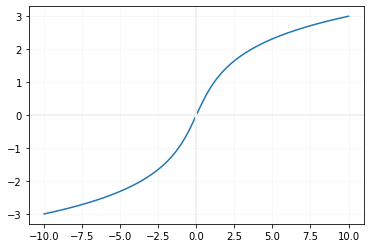asinh()
import math
print(math.asinh(1)) # 0.8813735870195429
print(math.asinh(1.5)) # 1.1947632172871094
print(math.asinh(5)) # 2.3124383412727525With negative input numbers
import math
print(math.asinh(-1)) # -0.8813735870195429
print(math.asinh(-8.1)) # -2.788800040920179Inputs in degree
We can convert radian value to degree and use the sameimport math
in_degree = 60
in_redian = math.radians(in_degree)
print(math.asinh(in_redian)) # 0.91435665539288590.9143566553928859 1 radian = 57.2957914331 degree
1 degree = 0.0174533 radian
1 degree = 0.0174533 radian
Drawing graph of asinh()
We will use Matplotlib to generate graph of asinh
import matplotlib.pyplot as plt
x=[]
y=[]
i=-10
while (i<=10):
x.append(i)
y.append(math.asinh(i))
i=i+0.1
plt.plot(x,y)
plt.axvline(x=0.00,linewidth=2, color='#f1f1f1')
plt.axhline(y=0.00,linewidth=2, color='#f1f1f1')
plt.grid(linestyle='-',
linewidth=0.5,color='#f1f1f1')
plt.show()Example 1: Handling Negative Inputs
import math
print(math.asinh(-2)) # Output: -1.4436354751788103Example 2: Using cmath for Complex Numbers
import cmath
z = complex(2, 3)
print(cmath.asinh(z)) # Handles complex input(1.9686379257930964+0.9646585044076028j)Example 3: Hyperbolic Calculations in Engineering
import math
x = 1.5
result = math.asinh(x)
print(result) # Output: 1.1947632172871094
Subhendu Mohapatra
Author
🎥 Join me live on YouTubePassionate about coding and teaching, I publish practical tutorials on PHP, Python, JavaScript, SQL, and web development. My goal is to make learning simple, engaging, and project‑oriented with real examples and source code.
Subscribe to our YouTube Channel here
This article is written by plus2net.com team.
https://www.plus2net.com

 Python Video Tutorials
Python Video Tutorials